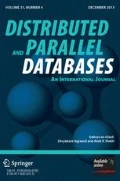This special issue of Distributed and Parallel Databases journal covers recent advances in spatio-temporal data analytics in the context of urban computing. It contains 9 articles that present solid research studies and innovative ideas in the area of spatio-temporal data analytics for urban computing applications. All of the 9 papers went through at least two rounds of rigorous reviews by the guest editors and invited reviewers.
Location-based recommender systems are becoming increasingly important in the community of urban computing. The paper, by Hao Zhou et al., “Hybrid route recommendation with taxi and shared bicycles,” develops a two-phase data-driven recommendation framework that integrates prediction and recommendation phases for providing reliable route recommendation results. Another paper, by Hao Zhang et al., “On accurate POI recommendation via transfer learning,” proposes a transfer learning based deep neural model that fuses cross-domain knowledge to achieve more accurate POI recommendation.
Spatial keyword search has been receiving much attention in area of spatio-temporal data analytics. Xiangguo Zhao et al. develop anindex structure that comprehensively considers the social, spatial, and textual information of massive-scale spatio-temporal data to support social-aware spatial keyword group query in their paper “Social-aware spatial keyword top-k group query.” Jiajie Xu et al. propose a hybrid indexing structure that integrate the spatial and semantic information of spatio-temporal datain their paper “Multi-objective spatial keyword query with semantics: a distance-owner based approach.”
Matching of spatio-temporal data is a fundamental research problem in spatio-temporal data analytics. The paper, by Ning Wang et al., “An efficient algorithm for spatio-textual location matching,” targets the problem of finding all location pairs whose spatio-textual similarity exceeds a given threshold. This matching query is useful in urban computing applications including hot region detection and traffic congestion alleviation. Additionally, their paper “Privacy-preserving spatial keyword location-to-trajectory matching,” presents a network expansion algorithm and pruning strategies for finding location-trajectory pairs from spatio-temporal data while preserving the users’ privacy.
Further, the paper, by Lei Xiao et al., “LSTM-based deep learning for spatial–temporal software testing,” developsa test case prioritization approach using LSTM-based deep learning, which exhibits potential application value in self-driving cars. Another paper, by Zhen chang Xia et al., “ForeXGBoost: passenger car sales prediction based on XGBoost,” presents a prediction model that utilizes data filling algorithms. The model achieves a high prediction accuracy with short running time for vehicle sales prediction. Finally, the paper, by Zhiqiang Liu et al., “A parameter-level parallel optimization algorithm for large-scale spatio-temporal data mining,” propose an efficient parameter-level parallel optimization algorithm for large-scale spatio-temporal data mining.
Those nine articles represent diverse directions in the fast-growing area of spatio-temporal data analytics in urban computing community. We hope that these papers will foster the development of urban computing techniques and inspire more research in this promising area.
Author information
Authors and Affiliations
Corresponding author
Additional information
Publisher's Note
Springer Nature remains neutral with regard to jurisdictional claims in published maps and institutional affiliations
Rights and permissions
About this article
Cite this article
Shang, S., Zheng, K. & Kalnis, P. Introduction to spatio-temporal data driven urban computing. Distrib Parallel Databases 38, 561–562 (2020). https://doi.org/10.1007/s10619-020-07300-3
Published:
Issue Date:
DOI: https://doi.org/10.1007/s10619-020-07300-3

